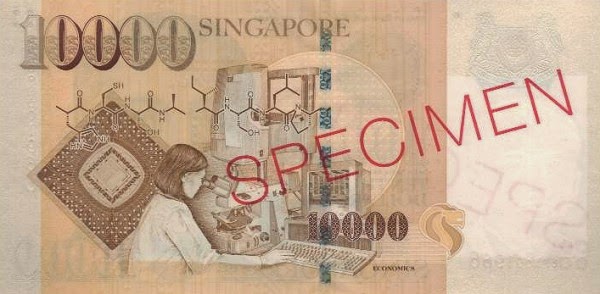 |
| Singapore banknotes |
 |
| Singapore paper money |
Singapore banknotes 10000 Dollars banknote Portrait Series 1999–present
Singapore dollar, Singapore banknotes $10000 SGD, Singapore paper money 10000 dollar note, Singapore bank notes, Singapore dollar bills - world banknotes money currency pictures gallery.The Portrait notes are the fourth series of currency notes launched on 9 September 1999. The new series marks the first time a portrait has been featured as its main design theme. The portrait of Singapore's first President, the late Encik Yusof Bin Ishak was chosen in honour of his invaluable contribution towards nation building. (Tun Yusof bin Ishak (12 August 1910 – 23 November 1970) was the first President of Singapore, serving from 1965 to 1970.)
The front of all the notes feature the Singapore Arms, a watermark of the portrait, the Singapore Lion symbol, the word Singapore in the four official languages, as well as the signature and seal of the Chairman, BCCS or Chairman, MAS. The back of each denomination features a unique theme based on the first President's biography. The themes are Education, Garden City, Sports, Arts, Youth, Government and Economics.
The Portrait series has to strike a balance between simplicity and clarity in design on one hand and sophistication in security features on the other. At the same time, the public-recognition security features must be effective and easy for users to recognise and remember. To help meet these requirements, a standard designing approach was adopted across all denominations of the Portrait series.
The back of the $10,000 note depicts the future direction of our economy-one which is knowledge-based and technology-driven. It features a research scientist working on high-technology laboratory equipment. A microprocessor and a silicon wafer, representing Singapore's drive to create a high-tech manufacturing hub, are seen in the backdrop on the left and right-hand side respectively. Partial sequences of two proteins, the tyrosine kinase and the tyrosine phosphatase, representing two important breakthroughs in research by the Institute of Molecular and Cell Biology (IMCB), appear at the top. A subtle background pattern of the printed circuit board completes the design.
The Onyx Cowri`e (Cypraea onyx Linnaeus, 1758) is also shown on the $10,000 note. The jet black base, the brown and usually banded back, and the white pearly overlay on the sides or the whole shell make identification of this species easy. The mantle of the live specimen is greyish with many tiny circular dots very closely distributed on it. A variant of this animal from Sri Lanka is reportedly considered a food item.
An Indo-West Pacific cowrie, this species has been reported from shallow muddy waters in Singapore, as well as at depths of 30 m or more in Japan.
Colour: Gold
Size of note: 180 mm x 90 mm
First issued on: 9 September 1999 (Paper)
Banknotes signed by BCCS Chairman Richard Hu (September 1999) are currently in general circulation. It is one of the highest-value banknote in the world in terms of absolute value (approx. US$7,700) that is in public circulation. Even though larger denominations being withdrawn around the world, the MAS has retained the use of the $10,000 denomination, which continues to account for a significant value of the total cash currently in circulation.
4th Series – Singapore Portrait Series currency notes 1999–present
The current Portrait series was introduced in 1999, with the one- and 500-dollar denominations omitted. These notes feature the face of Yusof bin Ishak, the first president of the Republic of Singapore, on the obverse, and the reverse depicts a feature of civic virtue. There are both paper and polymer notes in circulation. The designs of the polymer notes are very similar to the corresponding paper note except for the slightly slippery feel and a small transparent window design in the corner of the banknote. Polymer notes are progressively replacing the paper banknotes in circulation. The notes also have Braille patterns at the top right-hand corner of the front design.
1000 Dollars 10000 Dollars